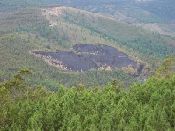|
Evaluating the desertification risk assessment tool with local experimental results |
 |
|
Author: Victor Jetten
Introduction
The Boteti study area has overgrazing as the degradation challenge. The extent of overgrazing in pastures, woodland and settlements is fragile to critical. Firewood collection adds to the range degradation, thus alternative energy in the form of biogas has been proposed by the stakeholders. Firewood is the main source of energy, not only in common households but also in schools and communal centers. Since cattle is one of the main sources of income, biogass might be a valuable alternative. The generated gas is expected to reduce heavy firewood use and even promote socio-economic activities which will reduce poverty – perceived to be one of the main drivers of land degradation other than droughts.
Desertification indices
The desertification risk analyzed here is overgrazing. Using the parameters for a flat poorly vegetated area with deep soil, the overgrazing risk is considered very high (4.76). The two main factors here are however to do with farm size. Since there are no farms but communal grazing areas the selected variables are larger than 100 ha and low fragmentation 1-4. If these variables are not included the overgrazing drops respectively to low (2.41). Biogas cannot be done directly. The only thing that can be assumed is that the cover increases, but this has little influence.
Conclusion
The communal razing cannot be correctly identified in Botswana, overgrazing is classified as high risk but for the wrong apparent reasons (farm size), which overrule other changes in the desertification risk assessment tool (vegetation related).
|



